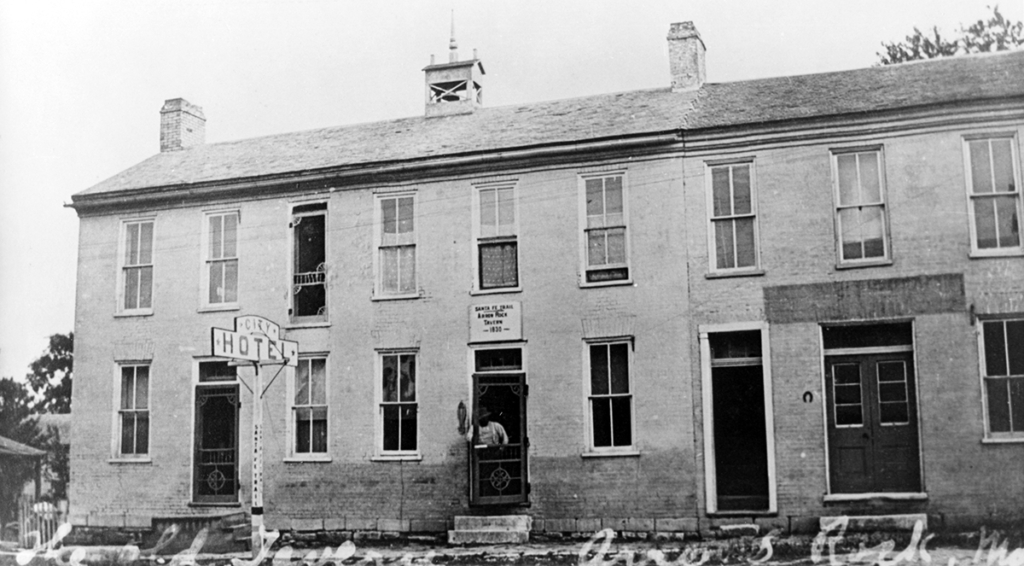
ABOUT ARROW ROCK
History written by Sandy Selby. Used with permission.
A small section of Missouri River bluff, in a spot that would come to be known as Arrow Rock, was an abundant source of flint. It became so well known among Native Americans who relied on flint to craft arrowheads, that the first person to record the place’s name—a French cartographer who passed through the area in 1732—called it Pierre à Fleche, or Rock of Arrows.
Nearly 90 years later, in 1821, a man named William Becknell and four companions crossed the Missouri River and set up camp for the night on that flint-rich bluff. They were on their way to Santa Fe on what history would remember as the first successful trading trip on the Santa Fe Trail.
The Missouri River brought goods and people past the bluff, the Santa Fe Trail brought adventurous pioneers across the river and deposited them at the “Rock of Arrows,” so it’s no mystery why enterprising men and women decided to establish a town in that spot in 1829.
With a location that practically assured success, the town grew quickly. Merchants and innkeepers set up shop. Plantations sprung up on fertile farmland nearby and shipped their goods from the river port in Arrow Rock to eager customers in the Deep South.

Men of influence made their home in the thriving village. Dr. John Sappington, the physician who popularized the use of quinine as a treatment for malaria with his Dr. Sappington’s Anti-Fever Pills, and acclaimed artist George Caleb Bingham made their homes in Arrow Rock. Three governors—Meredith Miles Marmaduke, Claiborne Fox Jackson, and John Sappington Marmaduke—hailed from Arrow Rock.
Good fortune seemed to encircle the prosperous little city, but a devastating war and the fickle whims of a river changed everything.
The Great Decline
Arrow Rock found itself on the losing side in the Civil War. The town had been settled predominantly by Southerners from states such as Virginia, Kentucky and Tennessee, and Arrow Rock’s prosperity was tied to trade with the South. When the South lost the war, Arrow Rock lost its political and economic clout. The town barely had time to absorb that blow when two fires—the first in 1872 and another in 1901—razed much of the town’s business district.
People were departing in droves, but Arrow Rock’s string of bad luck wasn’t over. The river was also on the move, carving a new channel that abandoned Arrow Rock, and transportation was shifting from rivers to rails. Pioneers had crossed the Missouri River on a ferry to Arrow Rock for more than a century, but the railroad would not follow that old route. The 20th century dawned on a dying town.

Unlikely Heroes
Americans were buying automobiles and they wanted somewhere to drive. In 1912, a group called the National Old Trails Road Association made it a mission to connect old trails, like the Santa Fe Trail, and create a coast-to-coast highway system with interesting attractions along the way. A handful of Arrow Rock residents and devotees, perhaps sensing it was the town’s last, best hope for survival, founded a local chapter of the National Old Trails Road Association and set up a museum room, featuring a hodgepodge of oddities and antiquities, in the old Arrow Rock Tavern.
The museum room was a modest success, but it took the intervention of another group to facilitate real and lasting change in Arrow Rock: the women of the Daughters of the American Revolution. The Arrow Rock Chapter of the DAR formed in 1921, and almost immediately set its sights on a project: the restoration of the crumbling Arrow Rock Tavern. The women went to work, lobbying the Missouri legislature until the lawmakers agreed to purchase the building for $5,000 in 1923. In exchange, the DAR agreed to become the permanent custodian of the building and manager of its restaurant and lodging businesses.
The tavern restoration and resulting influx of tourists to out-of-the-way Arrow Rock got the attention of the State of Missouri. The Missouri State Parks system was still in its infancy when it staked out the land surrounding the tavern to create the Arrow Rock State Park in 1926. As the decades passed, the park expanded and became a destination for day-trippers and campers, but the rest of Arrow Rock continued to deteriorate.
In the mid-1950s, hope arrived in the form of Bill and Cora Lee Miller, a preservation-minded couple who set out to restore a dilapidated old house on Main Street at a time when it was far more fashionable to bulldoze the outdated to make way for the modern. The Millers were joined by others who took on the arduous work of restoring luster to fading old homes in the area.
Those early preservationists, along with key members of the DAR, were convinced that Arrow Rock was worth saving, and they led the effort by founding the Friends of Arrow Rock, a historic preservation and history education nonprofit, in 1959. Two years later, the Arrow Rock Lyceum Theatre opened.
A town once on the precipice of oblivion was reinvigorated and continues to be sustained by historic preservation and the arts.
